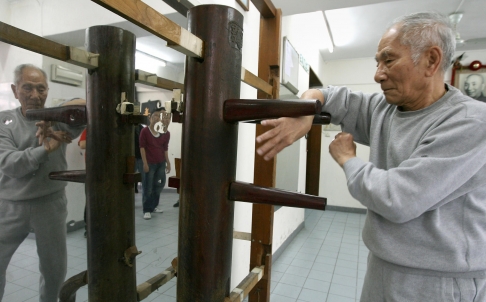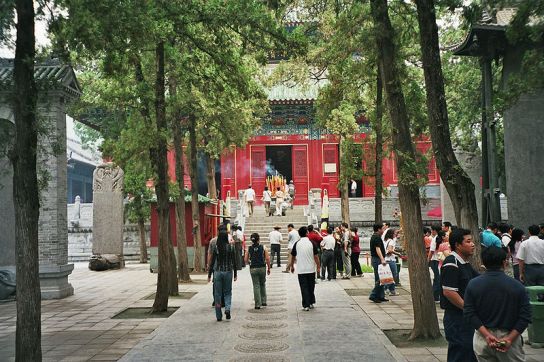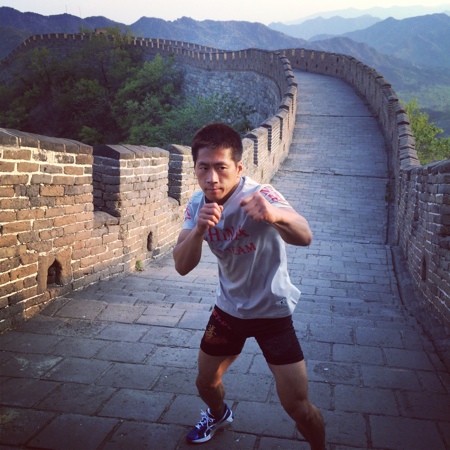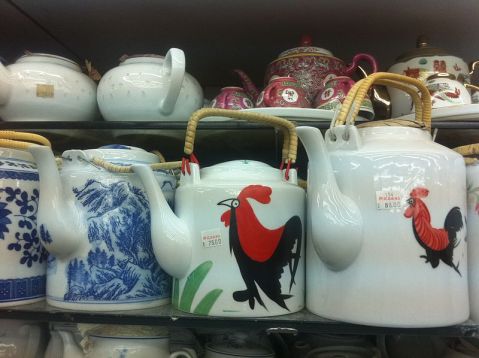
Introduction
Welcome to “Chinese Martial Arts in the News.” This is a semi-regular feature here at Kung Fu Tea in which we review media stories that mention or affect the the traditional fighting arts. In addition to discussing important events, this column also considers how the Asian hand combat systems are portrayed in the mainstream media.
While we try to summarize the major stories over the last three weeks, there is always a chance that we have missed something. If you are aware of an important news event relating to the TCMA, drop a link in the comments section below. If you know of a developing story or event that should be covered in the future feel free to send me an email.
Its been a while since our last update so there is a lot to be covered in today’s post. Lets get to the news!
Community Losses
Our review of recent events starts with two sad notes. On August 27th Sifu James Wing Woo passed away. While not as high profile as some other practitioners, Woo was a true pioneer of the Chinese martial arts in North America. Born in the United States in 1922, he spent much of his childhood in Guangzhou before returning to California in 1938. His life story is interesting and worth checking out. In historical terms Woo might be best remembered for his short association with Ed Parker. This resulted in the publication of Parker’s book Secrets of Chinese Karate, much of which is thought to have been written by Woo. In that way Woo helped to shape one of the first highly successful books on the Chinese martial arts available to the western public. A public memorial and birthday party has been tentatively scheduled for September 27th.
The southern Chinese martial arts community also suffered the unexpected loss of Sifu James Cama. An inheritor of both the Buddha Palm Wing Chun system and Southern Mantis, Cama also had an exceptionally fruitful teaching career. Those interested in his legacy might want to take a look at the extensive interview which he provided for Jonathan Bluestein in his recent book Research of Martial Arts. Cama also released his own volume on Fut Sao Wing Chun shortly before his death.

Preserving the Traditional Martial Arts
A number of news stories in the last few months have focused on the opportunities and challenges of preserving the Chinese hand combat systems in the current era. Perhaps the most colorful of these centered on a dispute within the Wing Chun community as to whom the system should accept as its “official inheritor.” Anyone familiar with the modern history of the art knows that this has been a toxic subject. While Ip Man did not see fit to name a sole successor to his line (he instead founded the VTAA to carry on the teaching of his system), it has not stopped various students from trying to appropriate his mantle. Likewise there have been disputes between the various Wing Chun clans in Hong Kong and Guangdong as to who can rightfully claim priority.
Just when it seemed that we had reached a lull in the controversy, the Provincial Government of Guangdong decided that they wanted to honor Wing Chun as an important aspect of the area’s intangible cultural heritage. Yet to be included on the list all practices and crafts must list an official “inheritor.” In a choice that seems to have made no one happy the provincial committee named Ip Chun, Ip Man’s eldest son (and a resident of Hong Kong, rather than Guangdong) the systems inheritor. You can head on over to this article in the South China Morning Post to see how that decision was greeted. Setting aside the actual substance of the dispute, this seems like a great case study in what happens when you mix provincial bureaucratic politics and preexisting lineage disputes, something that is happening more frequently within the world of the Chinese martial arts.

It is interesting to compare this situation to recent efforts at cultural preservation in Hong Kong. That city also released a list of heritage items and practices deserving preservation. It was gratifying to see that various martial arts styles (including Wing Chun) were well represented. The Hong Kong committee was even careful to include multiple lineages of some of the larger hand combat systems in an attempt to head off public controversy. Nevertheless, these “preservation efforts” did not include any form of institutional or financial backing. Aside from offering public recognition, the government stated that it was up to private actors to step in and provide the support (financial or otherwise) necessary to preserve these practices.
It looks like Hing Chao’s “International Guoshu Association” and the City University of Hong Kong have decided to do just that. They have initiated a project called the “Hong Kong Living Archive.” Using advanced 3D motion capture technology and computer analysis they hope to build a library of southern China’s unique martial culture. To make this project a possibility they have launched a crowd-funding campaign on Fringebacker. The campaign was even profiled in a recently article at endgaget. Good luck to them in meeting their funding goals. This looks like a fascinating project.
Lastly Master Ma Hai Long, a leading figure in the Wu Taijiquan clan, visited Louisville Kentucky where he led a seminar. It sounds like a great event. I was particularly interested in the emphasis on Master Ma’s longevity and energy in the article reporting on the event. It certainly seems that the image of the “little old Chinese man” (discussed so well by Adam Frank) continues to be a central organizing symbol in the public perception of the martial arts.

New Directions in the Traditional Chinese Martial Arts
Of course no discussion of the news would be complete without an update on the ever surprising Shaolin Temple. This venerable institution recently made headlines when it started running advertisements for job openings in Beijing newspapers. If you are interested in brand development, speak English as well as Mandarin and want to work at the Shaolin Temple, this could be your big chance. No prior background in the martial arts is needed but a familiarity with Zen culture is a plus. Honestly I find this add to be a bit surprising. Given that there is a new wacky story about Shaolin coming out every week or two, I would have thought that they already had a brand management team in place.
The Shaolin Temple also made headlines in China by announcing plans to offer courses in meditation to busy entrepreneurs and CEOs. It was probably only a matter of time until the Temple found some way to monetize their religious heritage. Nor is this arrangement really all that unique. While living in Japan I spent some time at a temple that ran a very similar program that also catered to business people. Still, its fascinating to note that all of the articles on this subject feature images of Kung Fu monks rather than meditating corporate officers.
While its easy to be snarky about these sorts of efforts, I am genuinely curious as to how they will be received. The traditional fighting arts have fallen on hard times in mainland China precisely because they have come to be seen as “impractical” and “detached” on a number of different levels. While practitioners debate their practicality vs. MMA or Muay Thai, what most parents seem to care about is that these pursuits take time away from school and do nothing to better their children’s career prospects. This suggests that one way of increasing the appeal of these fighting systems is by re-framing their value in a modern economic setting.
Of course the Japanese did just that with their high school Judo and Kendo clubs back in the 1960s and 1970s. This recent article linking the traditional Chinese martial arts to career success seems to be moving in a similar direction. I remember back in the late 1980s and early 1990s when American businessmen were all reading Mushashi Miyamoto’s Book of Five Rings for hidden insights into Japanese business strategy. Maybe in a couple of year we will see subway cars full of guys in grey suites reading the “Taiji Classics” or the “Tao of Jeet Kune Do?”

Media and the Martial Arts
It has been a slow couple of weeks so far as the Chinese martial arts in the media and entertainment industry are concerned. One bright spot was the release of a teaser trailer for an upcoming documentary titled “The New Masters.” You can see it here. This film will offer an insider look at the state of the martial arts in China today from the middlemen and promoters of the growing MMA scene to masters of traditional southern Boxing. Watch for more news on this project in the coming months.
Martial arts studies
The summer is traditionally a slow time for most academics, but we have seen a number of important developments on the martial arts studies front. Jacob Murphy just posted the text of a paper that he gave at the recent “What Happens Now” conference hosted at the University of Lincoln. It is titled “Direction and Misdirection: An Attempt to Reconcile Martial Arts with the Literary Arts.” The paper starts off with the observation that the martial arts seem to have invaded both academia and literature. This piece will be of primary interest to literary and cultural theorists.
William Acevedo has recently made a more sociologically oriented contribution to the discussion. We often note that the traditional martial arts have become a global project. Much the same can be said for martial arts studies. Still, most of our discussions focus only on contributions made in the English language (and more rarely the Chinese) literature. He helps to balance this vision by providing a discussion of the growth of martial arts studies in Latin America. Hopefully in the near future we can add discussions of what is happening in Europe and Japan. In this way we can start to build a truly global conversation between scholars and practitioners.
The “Brennan Translations Blog” has just released two new texts. These are “A Simple Introduction to Taiji Boxing” by Xu Zhiyi (1927) and “The Biography of Wang Zhenghan, also known as ‘Boxing Methods of the Internal School.'” by Huang Baijia (1676). Both of these texts are interesting, but the second is vitally important to many of the historical discussions that circulate around the Chinese martial arts today. This text was the first to advance the concept of an “internal art” and to associate the legendary Daoist figure Zhang Sanfeng with its origin. We are fortunate that this important text has received another careful translation.
Speaking of translations, Bernard Kwan (who runs the excellent blog “Be Not Defeated by the Rain”) has been working on the English language edition of Hing Chao’s recent volume, The Hong Kong Martial Arts Community. This encyclopedic work provides the most detailed review to date of the various martial arts lineages that are practiced in Hong Kong and Southern China. Bernard has recently posted his own review of this project (including some possible criticisms) at his blog. It makes me eager to see the English language release of this volume.
While not directly related to the Chinese hand combat systems, I did see one final press release that I wanted to include in this section. It turns out that “Kung Fu Diplomacy” can also be carried out in the academic realm. A symposium on the Japanese art of Ninjitsu was recently held in Beijing. The conference helped to bring together historians from China, Japan and Korea to discuss an important (and increasingly popular) element of Japan’s martial heritage. This multilateral discussion was framed as an opportunity for scholars to reach across the increasingly acrimonious regional divides that separate their respective states in the political realm. Hopefully this discussion advanced Martial Arts Studies as a transnational project in the region.

Kung Fu Tea on Facebook
There is always a lot going on at the Kung Fu Tea Facebook group. This last month has been no exception. We looked at a number of documentaries on various styles of Chinese boxing, reviewed an academic article on gender in modern Muay Thai Kickboxing, watched some rare footage of traditional Mongolian archers and found out exactly where the melody of the “Kung Fu Fighting” song actually came from.
If its been a while since your last visit, head on over and see what you have been missing!
oOo
If you enjoyed this you might also want to read: Two Encounters with Bruce Lee: Finding Reality in the Life of the Little Dragon
oOo
September 8, 2014 at 2:42 am
Hi Ben, thanks for another great article.
I was reading through your article and checked out some references, and one reference in particular was quite interesting.
I was looking at one of the recent translations at Brennan Translations Blog regarding the biography of Wang Zhengnan:
http://brennantranslation.wordpress.com/2014/08/29/boxing-methods-of-the-internal-school-nei-jia-quan-fa/
I was browsing through the description of Wang Zhengnan’s fighting style, and it reminded me a lot of the article your wrote regarding Zhang Songxi:
https://chinesemartialstudies.com/2012/09/07/zhang-songxi-ming-era-southern-boxing-and-the-ancient-roots-of-modern-wing-chun/
Now don’t get me wrong, I am not trying to go on about another Wing Chun creation theory, but I was quite intrigued by the descriptions used in Wang Zhengnan’s fighting style.
Take for example this:
There are many prohibitions against bad habits: do not be lazy, sluggish, or slouching, do not raise your shoulders, step like an old man, stick out your chest, stand too upright, pamper your legs, lift your elbows, jab with your punches, stick your butt out, bend at the waist, attack unguarded, or put out both hands with the same reach.
The above ‘prohibitions’ when you start to analyse it really points out a certain ‘Southern’ structure. Don’t raise your shoulders or stick out your chest. Don’t stand too upright . Don’t lift your elbows or jab. Don’t put out both hands with the same reach (which implies having hands out at a different reach, i.e. one hand out and one hand back).
The description for the ‘reaching punch’ is also quite interesting:
THROUGH-THE-ARM (another name for reaching punch):
Your right hand, starting out with its palm facing downward, sends out a reaching punch, your left hand bending in toward your chest. Then your left hand goes from below your right fist, also coming out as a reaching punch, your right hand bending in to your chest. Repeat this for a total of four punches. Your feet are in an alignment stance and go along with your reaching punches by pivoting side to side. Reaching punches should always be pointing as a vertical fist with the back of the hand slightly visible to you, for punching with the back of the hand facing outward [i.e. bending the wrist inward] is a bad habit that will lead to sprains.
I thought the description reminded me somewhat of the Chain Punch (with pivoting added). Note the vertical fist alignment and the simultaneous retraction/firing of the punches.
Note how Wang Zhengnan, Zhang Songxi, Huang Zongxi and his son Huang Baijia are within the province of Zhejiang. Now while there is debate on the whole ‘internal’ thing (as there’s a probable political element attached to that), I think there is a ‘regional’ point to be made here. Are the martial arts that these individuals practised simply Ming to early Qing era southern martial arts?
I’d like to get your comment on this.
Thanks
Leon
September 8, 2014 at 12:10 pm
Hi Leon,
I will start with the caveat that attempting to reconstruct how a given style was actually performed from relatively short written descriptions like this is a very difficult undertaking.
Still, I agree that we can see a regional dynamic going on here. While there are lots of efforts to link these texts to more northern styles (including Taiji), I don’t think its much of a stretch to actually see them as better descriptors of older southern boxing styles. If nothing else this indicates that martial knowledge tended to circulate within the country, rather than flowing in an exclusively North -> South direction, which is what so many popular folk histories tend to assume. The fact that this is happening in Zhejiang is particularly important as that was an area that tended to be well off and to have enjoyed highly developed martial traditions. Lots of people (including the Japanese) went to this area to study martial arts (particularly pole and spear fighting). That is my quick 2 cents worth.